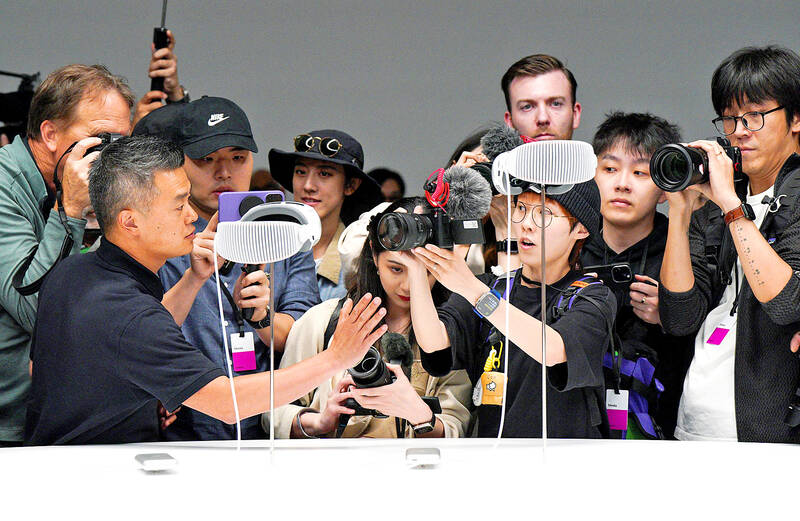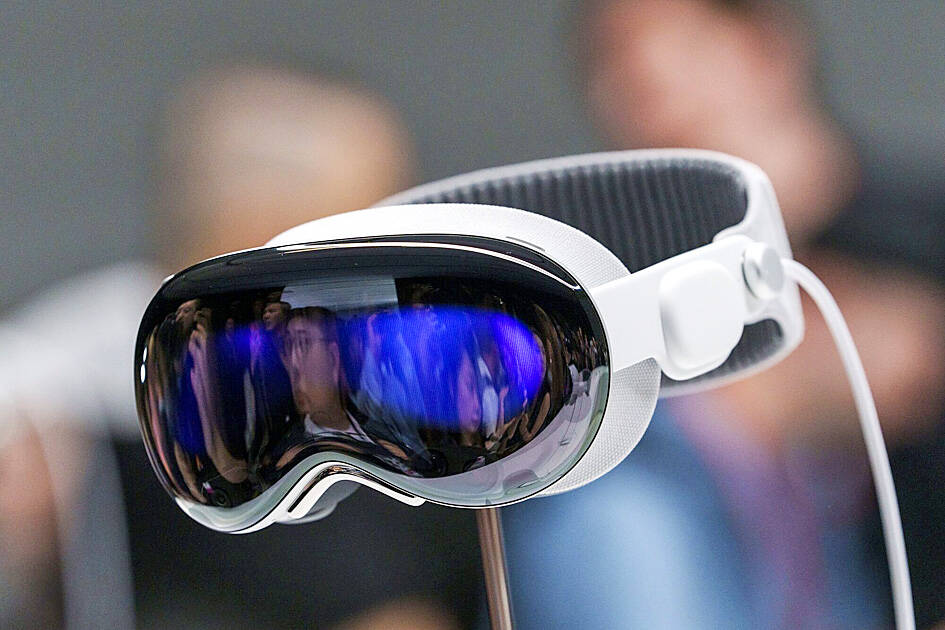Apple Inc on Monday unveiled a long-rumored headset that would place users between the virtual and real world, while also testing the technology trendsetter’s ability to popularize new-fangled devices after others failed to capture the public’s imagination.
After years of speculation, Apple CEO Tim Cook hailed the arrival of the sleek goggles — dubbed “Vision Pro” — at the company’s annual developers’ conference held on a park-like campus in Cupertino, California.
The device would be capable of toggling between virtual reality (VR) and augmented reality (AR), which projects digital imagery while users can still see objects in the real world.

Photo: Reuters
“This marks the beginning of a journey that will bring a new dimension to powerful personal technology,” Cook told the crowd.
Although Apple executives provided an extensive preview of the headset’s capabilities during the final half hour of Monday’s event, consumers would have to wait before they can get their hands on the device and prepare to pay a hefty price to boot. Vision Pro is to sell for US$3,500 once it is released in stores early next year.
“It’s an impressive piece of technology, but it was almost like a tease,” Gartner Inc analyst Tuong Nguyen said. “It looked like the beginning of a very long journey.”

Photo: Bloomberg
Instead of merely positioning the goggles as another vehicle for exploring virtual worlds or watching more immersive entertainment, Apple framed the Vision Pro as the equivalent of owning an ultrahigh-definition TV, surround-sound system, high-end camera, and state-of-the art camera bundled into a single piece of hardware.
The company emphasized that it drew upon its past decades of product design during the years it spent working on the Vision Pro, which Apple said involved more than 5,000 different patents.
The headset would be equipped with 12 cameras, six microphones and a variety of sensors that would allow users to control it and various apps with only their eyes and hand gestures.
The experience would not cause the recurring nausea and headaches that similar devices have in the past, Apple said.
The firm also developed a technology to create a three-dimensional digital version of each user to display during video conferencing.
Although the Vision Pro would not require physical controllers that can be clunky to use, the goggles would have to either be plugged into a power outlet or a portable battery tethered to the headset — a factor that could make it less attractive for some users.
“They’ve worked hard to make this headset as integrated into the real world as current technology allows, but it’s still a headset,” Insider Intelligence analyst Yory Wurmser said, adding that the unveiling was still a “fairly mind-blowing presentation.”
Even so, analysts are not expecting the Vision Pro to be a big hit right away. That is largely because of the hefty price, but also because most people still cannot see a compelling reason to wear something wrapped around their face for an extended period of time.
The public’s response to virtual, augmented and mixed reality has been decidedly ho-hum so far. Wedbush Securities Inc analyst Dan Ives estimated Apple would sell just 150,000 of the headsets during its first year on the market before escalating to 1 million headsets sold during the second year — a volume that would make the goggles a mere speck in the company’s portfolio.
By comparison, Apple sells more than 200 million of its marquee iPhones a year.
However, the iPhone was not an immediate sensation, with sales of fewer than 12 million units in its first full year on the market.

The US dollar was trading at NT$29.7 at 10am today on the Taipei Foreign Exchange, as the New Taiwan dollar gained NT$1.364 from the previous close last week. The NT dollar continued to rise today, after surging 3.07 percent on Friday. After opening at NT$30.91, the NT dollar gained more than NT$1 in just 15 minutes, briefly passing the NT$30 mark. Before the US Department of the Treasury's semi-annual currency report came out, expectations that the NT dollar would keep rising were already building. The NT dollar on Friday closed at NT$31.064, up by NT$0.953 — a 3.07 percent single-day gain. Today,

‘SHORT TERM’: The local currency would likely remain strong in the near term, driven by anticipated US trade pressure, capital inflows and expectations of a US Fed rate cut The US dollar is expected to fall below NT$30 in the near term, as traders anticipate increased pressure from Washington for Taiwan to allow the New Taiwan dollar to appreciate, Cathay United Bank (國泰世華銀行) chief economist Lin Chi-chao (林啟超) said. Following a sharp drop in the greenback against the NT dollar on Friday, Lin told the Central News Agency that the local currency is likely to remain strong in the short term, driven in part by market psychology surrounding anticipated US policy pressure. On Friday, the US dollar fell NT$0.953, or 3.07 percent, closing at NT$31.064 — its lowest level since Jan.

The New Taiwan dollar and Taiwanese stocks surged on signs that trade tensions between the world’s top two economies might start easing and as US tech earnings boosted the outlook of the nation’s semiconductor exports. The NT dollar strengthened as much as 3.8 percent versus the US dollar to 30.815, the biggest intraday gain since January 2011, closing at NT$31.064. The benchmark TAIEX jumped 2.73 percent to outperform the region’s equity gauges. Outlook for global trade improved after China said it is assessing possible trade talks with the US, providing a boost for the nation’s currency and shares. As the NT dollar

The Financial Supervisory Commission (FSC) yesterday met with some of the nation’s largest insurance companies as a skyrocketing New Taiwan dollar piles pressure on their hundreds of billions of dollars in US bond investments. The commission has asked some life insurance firms, among the biggest Asian holders of US debt, to discuss how the rapidly strengthening NT dollar has impacted their operations, people familiar with the matter said. The meeting took place as the NT dollar jumped as much as 5 percent yesterday, its biggest intraday gain in more than three decades. The local currency surged as exporters rushed to